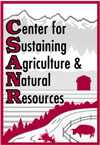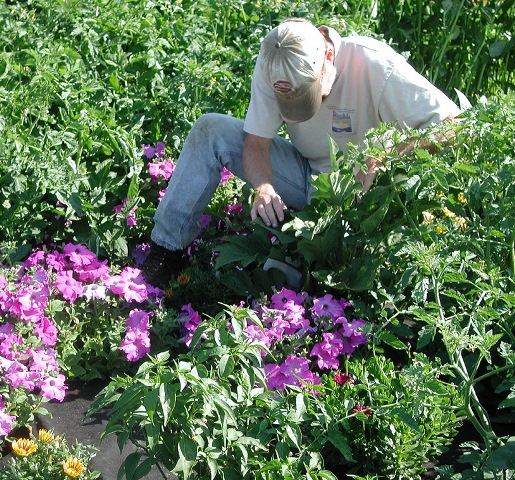The main ♣ WSU Gardening Resource website has many excellent publications and resources for Gardeners, including the ♣ Master Gardener’s program. Below are our program’s contributions, covering topics such as Nutrients and Amendments for Organic and Non-Organic Gardens, Cover Crops, Lead Contamination, Raised Beds, Biosolids, and Parking Strip Gardens.
Fertility, Amendments:
♣ A Home Gardener’s Guide to Soils and Fertilizers (PDF-Online). How can the home gardener maximize soil productivity? This guide gives detailed information on soil structure, fertility, and irrigation in your garden. Instructions on the appropriate use of both organic and synthetic fertilizers are provided, as well as information on creating and using compost. See below companion publication “Garden Fertilizer Calculator” to calculate your specific fertilizer needs. Cogger, C. 2014. WSU Extension EM063E.
♣ Garden Fertilizer Calculator (PDF with embedded Excel xlsx-Online). A companion publication to “A Home Gardener’s Guide to Soils and Fertilizers.” Read that bulletin (link above) for more in depth details on fertilizers and amendments. Gardens, lawns, single plants, or short rows: how much organic or conventional fertilizer to add for each? Cogger, C. 2019. WSU Extension, US Dept. Agriculture. FS324E
♣ Organic Soil Amendments in Yards and Gardens: How Much is Enough? (PDF-Online). Organic soil amendments can benefit most garden soils, however, applying too much can waste money, risk harming water quality, and even harm plants. This fact sheet describes the benefits of using organic soil amendments, the characteristics of the various types available, and most importantly, how much to apply in home gardens and landscapes. Cogger, C. and G. Stahnke. 2013 WSU Extension. FS123E
♣ Soil Fertility in Organic Systems – A Guide for Gardeners and Small Acreage Farmers (PDF-Online). This publication discusses the many types of fertilizers and soil amendments available for organic plant production. Fertilizer formulations, nutrient availability, and application practices for common organic products are also explained. While the primary focus is on building and maintaining fertile soil, information about how to protect soil and water resources in this context is included. Collins, D. C. Miles, C. Cogger, and R. Koenig. 2013. Pacific Northwest Extension Publication PNW 646.
♣ Inorganic Fertilizers for Home Garden Vegetables and Fruits in Central Washington (PDF-Online). This publication provides gardeners with information on how to read inorganic fertilizer labels and how to determine the need for fertilizer in the garden; inorganic fertilizer recommendations for garden fruits and vegetables; application methods and rates, and further reading resources on inorganic fertilizers. Desta, K., and C. Cogger. 2014. WSU Extension and US Dept. Agriculture. EM070E.
♣ Backyard Composting (PDF-Online). Curious about compost? Composting reduces waste and provides an inexpensive treatment for home gardens and landscapes. Whether you have been composting for years or want to start your first pile, this publication can guide you through the process successfully. Cogger, C., D.M. Sullivan, and A. Bary. 2017. WSU Extension, US Dept. Agriculture. EB1784E.
♣ Using Biosolids in Gardens and Landscapes (PDF-Online). Biosolids are a recyclable organic material produced in municipal wastewater treatment plants that can be used as fertilizer for gardens and landscapes. Class A biosolids meet the strictest pathogen standards, based on federal treatment and monitoring requirements and are the only biosolid available for home garden and landscape use. Research shows that biosolids build soil organic matter, improve soil tilth, and benefit crops under a wide range of conditions by providing nitrogen, phosphorus, and organic matter. Biosolids products are a locally produced and inexpensive source of plant nutrients and soil organic matter. Cogger, C. 2014. WSU Extension. FS 156E.
♣ Phosphorus and Home Lawns: Quick Facts and Recommendations (PDF-Online). Phosphorus (P) is an essential plant nutrient, but it is also a potential pollutant. Phosphorus fertilization helps maintain healthy lawns growing in P-deficient soils, but P runoff into lakes and streams can cause excessive growth of algae—harming water quality and aquatic ecosystems. Stahnke, G., E. Miltner, C. Cogger, S. Collman, J. Glass, M. Ophardt, and P. Tillery. 2012. WSU Extension and US Dept. Agriculture. FS058E.
Cover Crops:
♣ Cover Crops for Home Gardens West of the Cascades (PDF-Online). This WSU fact sheet focuses on choosing the best cover crops for gardens in Washington and Oregon, west of the Cascades. Other topics discussed in this fact sheet include what cover crops are, why grow them, and information on planting rates and dates. Cogger, C., C. Benedict, N. Andrews, and A. McGuire. 2014. WSU Extension. FS 111E.
♣ Cover Crops for Home Gardens East of the Cascades (PDF-Online). This WSU fact sheet focuses on choosing the best cover crops for gardens in Washington and Oregon, east of the Cascades. Other topics discussed in this fact sheet include what cover crops are, why grow them, and information on planting rates and dates. Cogger, C., C. Benedict, N. Andrews, S. Fransen, and A. McGuire. 2014. WSU Extension. FS 117E.
♣ Methods for Successful Cover Crop Management in Your Home Garden (PDF-Online). This fact sheet focuses on methods for managing garden cover crops, including planning, planting, managing nutrients, and terminating plants. Benedict, C., C. Cogger, and N. Andrews. 2014. WSU Extension. FS 119E.
Other:
♣ Raised Beds: Will They Benefit Your Vegetable Garden? (PDF-Online). Many vegetable gardeners use raised beds, while others successfully grow fruit and vegetables directly in native soil. Which system is best for you? This fact sheet describes the uses of raised beds and weigh benefits and disadvantages so you can decide if they are a worthwhile investment in your garden. The fact sheet also includes some basic tips on raised bed soil preparation and management. Cogger, C.G. 2017. WSU Extension Fact Sheet FS075E.
♣ Growing Food on Parking Strips and in Front Yard Gardens (PDF-Online). Parking strip and front yard vegetable gardens are increasingly popular in urban neighborhoods in Washington State. These locations may be the sunniest spots in the yard, and they offer an opportunity to expand garden space on small lots. These gardens not only provide fresh produce, but they can also be a source of neighborhood pride, bringing beauty to an urban streetscape and introducing neighbors to gardening and home-grown food. When planting a parking strip or front yard garden, it is important to assess the site and investigate any local ordinances that may affect it. It is also important to determine soil quality and environmental impacts, particularly on water quality, as well as safety concerns, such as food and traffic safety. Cogger, C. 2013. WSU Extension. FS 115E.
♣ Reducing Lead Hazard in Gardens and Play Areas (PDF/HTML-Online). This publication is designed to help homeowners evaluate and manage lead hazard in their landscape or garden. It explains how soils get contaminated with lead, how to test soil for lead contamination, and how to reduce exposure to soil lead. Brewer, L.J., D.M. Sullivan, P. Deol, and S.D. Angima. 2016. OSU Extension EC1616.




































